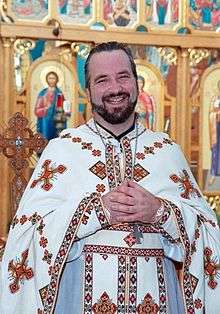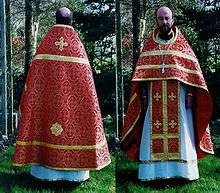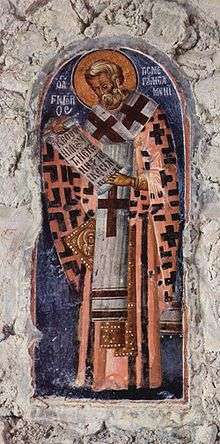Phelonion
The phelónion (Greek: φαιλόνιον (plural, φαιλόνια, phailónia; Latin paenula) is a liturgical vestment worn by a priest of the Eastern Christian tradition. It is worn over the priest's other vestments and is equivalent to the chasuble of Western Christianity.

Origin
Like the chasuble, the phelonion was originally a sort of poncho, a round vestment with a hole in the middle for the head, which fell to the feet on all sides. In its present form (dating from about the fifteenth century) the front is largely cut away (from about the waist down) to facilitate the movements of the priest's hands. In Russia the longer front remained common until quite recent times. The use of the phelonion is not limited to the Divine Liturgy but is specified for any major liturgical function. It is also called phenolion (φαινόλιον; plural phenolia φαινόλια) in some books.
Styles
There are two main styles of phelonion. Byzantine- or Greek-style phelonia are tailored to fit over the shoulders, while Russian-style phelonia (Фелонь, felon) have a high, stiffened collar that covers the back of the head. There is also a shortened phelonion (Фелончик, felonchik) that is worn by a reader at his tonsuring. This small phelonion is still worn by altar servers in Old Believers churches. The Greek-style phelonion is, generally speaking, worn by those with a historical and geographical closer tie with the Patriarch of Constantinople, which would include most Eastern Orthodox Christians in the Middle East, Greece, the Balkans, Romania, Bulgaria, as well as Greek-Catholics and Orthodox in western Ukraine.

The Russian-style phelonion is used by the Russian Orthodox, Ukrainian Autocephalous, Ukrainian Orthodox (Moscow Patriarchate), Polish Orthodox churches, as well as the Orthodox Church in America. There is also a version used by some Ukrainian and Bulgarian Orthodox which is half-way between the Russian and Greek styles.
A bishop who wishes to serve a Divine Liturgy as a priest (i.e., without the special rites and prayers of the Hierarchical Divine Liturgy) will sometimes vest in a phelonion instead of his sakkos, but with the omophorion around his neck. This is also done in the Liturgy of St. James. Originally, before the introduction of the sakkos, bishops wore a phelonion identical to that worn by priests, except that it was made of cloth that was either woven or embroidered with a pattern of multiple crosses, called a polystavrion ("many crosses").
In Oriental Orthodoxy, the phelonion is often only clasped at the neck, and is thus more open than the Byzantine-style, resembling a Western cope. Its various names are phanolion (Coptic), paynā (Assyrian), phayno (Syriac Orthodox), šurdzar (Armenian) and kāppā (Ethiopian). These are worn by bishops as well as priests (the sakkos is not worn by priests).
